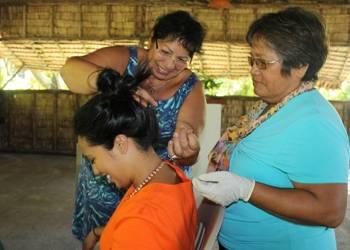Marshalls part of region-wide mercury study

Imogen Ingram, rear, with the assistance of Women United Together Marshall Islands staff member Miram Debrum, takes a hair sample during her visit to Majuro as part of a region-wide study of mercury levels in women. (Photo: Women United Together Marshall Islands)
http://www.mvariety.com/regional-news/89102-marshalls-part-of-region-wid...
MAJURO — The Marshall Islands is part of the region’s first study checking the levels of mercury in local residents.
Cook Islander Imogen Ingram, who is conducting the survey in at least five Pacific nations, visited Majuro and worked with the national women’s organization Women United Together Marshall Islands to take hair samples of 30 women that will be laboratory tested in the United States for mercury.
Ingram said the concern for mercury in the Pacific stems largely from fish contaminated with mercury from various sources. “The concern in the Pacific islands is people eat a lot of fish,” said Ingram, who works with the Island Sustainability Alliance of the Cook Islands in Rarotonga.
Ingram said she had herself tested and discovered that her body burden is two and a half times what is considered the maximum acceptable level of mercury in the United States. It motivated her to look at the situation region wide. She was able to get a grant to support the survey of women in multiple islands. She is taking small samples of hair in 30 women aged 18-44 in each island. A laboratory in the U.S. state of Maine is handling the analysis of the hair samples. So far, Ingram has completed work in Tonga, Cook Islands, and Marshall Islands, and was heading to Kiribati and Tuvalu to get further samples.
“We can’t stop eating fish, and I don’t want to scare people,” she said. “But it’s better that we know.” If the study shows high levels of mercury exposure, this is another piece of information that can be used to push developed nations to reduce the use of coal fired power plants, which as a byproduct of generating electricity produce mercury as gas that gets into rivers, land and oceans.
The women’s organization in Majuro helped Ingram to get the samples from women living in different parts of Majuro. The results won’t be available until the end of this year. Part of local organization’s role, she said, is to gather the participants to share the results and answer questions about them.
Despite the globally acknowledged hazard of mercury exposure, only two Pacific governments have expressed official interest in the Minamata Convention that was established to protect people and the environment from mercury exposure: Palau has signed but not yet ratified the agreement, while Samoa has ratified it.
There are a number of concerns in Pacific islands about exposure of local populations to dangerous chemicals — through incineration of plastics, for example, which produces highly toxic substances if not adequately filtered.
Ingram said her hope is this small survey she is conducting on the mercury exposure issue will put the spotlight on the issue and encourage the World Health Organization to support a bigger study in the region. She noted that the Oceans and Seas Global Conference is being held in Fiji in June next year, which will offer a platform for promoting awareness on the issue.
The United Nations Environment Program funded Ingram’s work with a grant to the International Persistent Organic Pollutants Elimination Network, which in turn provided a small grant to Ingram’s organization to carry out the study.
